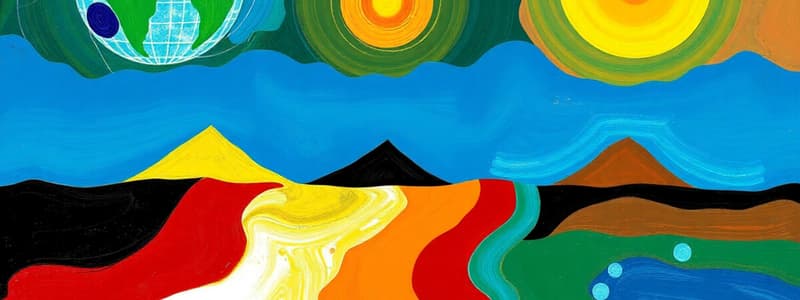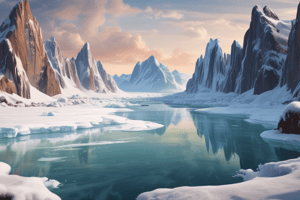Podcast
Questions and Answers
Which of the following is NOT considered a primary focus within the discipline of oceanography?
Which of the following is NOT considered a primary focus within the discipline of oceanography?
- Investigating marine life and ecosystems.
- Studying the chemical composition of ocean water.
- Analyzing weather patterns and climate change impacts. (correct)
- Understanding ocean currents, tides, and waves.
Which geological process is primarily responsible for the creation of new crustal material?
Which geological process is primarily responsible for the creation of new crustal material?
- Sedimentation in inland basins.
- Erosion at subduction zones.
- Volcanism at mid-ocean ridges. (correct)
- Weathering on continental landmasses.
What is the primary driving force behind the movement of Earth's tectonic plates?
What is the primary driving force behind the movement of Earth's tectonic plates?
- Convection currents in the mantle. (correct)
- Atmospheric pressure gradients.
- Changes in Earth's rotational speed.
- Gravitational pull of the moon.
In the context of the rock cycle, what is the key difference between sedimentary and metamorphic rocks?
In the context of the rock cycle, what is the key difference between sedimentary and metamorphic rocks?
Which of the following is NOT a direct consequence of plate tectonics?
Which of the following is NOT a direct consequence of plate tectonics?
What is the primary role of the asthenosphere in the context of plate tectonics?
What is the primary role of the asthenosphere in the context of plate tectonics?
What is the significance of studying the geological time scale in Earth science?
What is the significance of studying the geological time scale in Earth science?
Which process plays the most significant role in the transfer of water from the oceans to the atmosphere?
Which process plays the most significant role in the transfer of water from the oceans to the atmosphere?
Which of the following human activities is the LEAST likely to contribute to climate change?
Which of the following human activities is the LEAST likely to contribute to climate change?
Which of the following best describes the focus of environmental science as a discipline?
Which of the following best describes the focus of environmental science as a discipline?
Flashcards
What is Earth Science?
What is Earth Science?
The study of the Earth, its structure, processes, and history.
What is Geology?
What is Geology?
The study of Earth's solid materials and structures, including rocks and minerals.
What is Oceanography?
What is Oceanography?
The study of Earth's oceans, including their physical and chemical properties, and marine life.
What is Atmospheric Science?
What is Atmospheric Science?
Signup and view all the flashcards
What is Environmental Science?
What is Environmental Science?
Signup and view all the flashcards
What is Geography?
What is Geography?
Signup and view all the flashcards
What is the Earth's Crust?
What is the Earth's Crust?
Signup and view all the flashcards
What is Plate Tectonics?
What is Plate Tectonics?
Signup and view all the flashcards
What is Weathering?
What is Weathering?
Signup and view all the flashcards
What is the Hydrologic Cycle?
What is the Hydrologic Cycle?
Signup and view all the flashcards
Study Notes
The provided text contains no new information, therefore, the existing notes remain unchanged.
Studying That Suits You
Use AI to generate personalized quizzes and flashcards to suit your learning preferences.




